Efficient and Selective Multiple Ion Chemosensor by Novel Near-Infrared Sensitive Symmetrical Squaraine Dye Probe
Abstract
1. Introduction
2. Experimental Section
2.1. Materials and Instrumentation
2.2. Synthesis of SQ-68 and Dye Intermediates
3. Results
3.1. Physicochemical Properties of SQ-68
3.2. Absorption Studies of SQ-68 Towards Various Metal Cations
3.3. Competition and Response Time Study of SQ-68 with Cu2+ and Ag+
3.4. Sensing Mechanism of SQ-68 Response Toward Cu2+ and Ag+
3.5. Application to Environmental Water Samples
4. Conclusions
Supplementary Materials
Author Contributions
Funding
Institutional Review Board Statement
Informed Consent Statement
Data Availability Statement
Acknowledgments
Conflicts of Interest
Abbreviations
| NIR | Near-infrared |
| USEPA | United States Environmental Protection Agency |
| TLC | Thin layer Chromatography |
| Fmoc-Osu | N-(9-Fluorenylmethoxycarbonyloxy) succinimide |
| MeOH | Methanol |
| CH3CN | Acetonitrile |
| CH3Cl | Chloroform |
| EtOH | Ethanol |
References
- Hu, L.; Yan, Z.; Xu, H. Advances in synthesis and application of near-infrared absorbing squaraine dyes. RSC Adv. 2013, 3, 7667. [Google Scholar] [CrossRef]
- Ros-Lis, J.V.; Martínez-Máñez, R.; Sancenón, F.; Soto, J.; Spieles, M.; Rurack, K. Squaraines as Reporter Units: Insights into their Photophysics, Protonation, and Metal-Ion Coordination Behaviour. Chem. A Eur. J. 2008, 14, 10101–10114. [Google Scholar] [CrossRef] [PubMed]
- Ananda Rao, B.; Kim, H.; Son, Y.-A. Synthesis of near-infrared absorbing pyrylium-squaraine dye for selective detection of Hg2+. Sens. Actuators B Chem. 2013, 188, 847–856. [Google Scholar] [CrossRef]
- Dey, N.; Kulhánek, J.; Bureš, F.; Bhattacharya, S. Simultaneous Detection of Cu2+ and Hg2+ via Two Mutually Independent Sensing Pathways of Biimidazole Push–Pull Dye. J. Org. Chem. 2019, 84, 1787–1796. [Google Scholar] [CrossRef]
- Kim, H.N.; Ren, W.X.; Kim, J.S.; Yoon, J. Fluorescent and colorimetric sensors for detection of lead, cadmium, and mercury ions. Chem. Soc. Rev. 2012, 41, 3210–3244. [Google Scholar] [CrossRef]
- Yamanaka, M.; Hara, K.; Kudo, J. Bactericidal Actions of a Silver Ion Solution on Escherichia coli, Studied by Energy-Filtering Transmission Electron Microscopy and Proteomic Analysis. Appl. Environ. Microbiol. 2005, 71, 7589–7593. [Google Scholar] [CrossRef]
- Valko, M.; Morris, H.; Cronin, M. Metals, Toxicity and Oxidative Stress. Curr. Med. Chem. 2005, 12, 1161–1208. [Google Scholar] [CrossRef] [PubMed]
- Barceloux, D.G.; Barceloux, D. Copper. J. Toxicol. Clin. Toxicol. 1999, 37, 217–230. [Google Scholar] [CrossRef]
- Yao, J.; Zhang, K.; Zhu, H.; Ma, F.; Sun, M.; Yu, H.; Sun, J.; Wang, S. Efficient Ratiometric Fluorescence Probe Based on Dual-Emission Quantum Dots Hybrid for On-Site Determination of Copper Ions. Anal. Chem. 2013, 85, 6461–6468. [Google Scholar] [CrossRef] [PubMed]
- Velmurugan, K.; Raman, A.; Easwaramoorthi, S.; Nandhakumar, R. Pyrene pyridine-conjugate as Ag selective fluorescent chemosensor. RSC Adv. 2014, 4, 35284–35289. [Google Scholar] [CrossRef]
- Zhang, J.F.; Zhou, Y.; Yoon, J.; Kim, J.S. Recent progress in fluorescent and colorimetric chemosensors for detection of precious metal ions (silver, gold and platinum ions). Chem. Soc. Rev. 2011, 40, 3416. [Google Scholar] [CrossRef] [PubMed]
- Shum, S.C.K.; Pang, H.M.; Houk, R.S. Speciation of mercury and lead compounds by microbore column liquid chromatography-inductively coupled plasma mass spectrometry with direct injection nebulization. Anal. Chem. 1992, 64, 2444–2450. [Google Scholar] [CrossRef]
- Anderson, J.L.; Bowden, E.F.; Pickup, P.G. Dynamic Electrochemistry: Methodology and Application. Anal. Chem. 1996, 68, 379–444. [Google Scholar] [CrossRef]
- Katarina, R.K.; Takayanagi, T.; Oshima, M.; Motomizu, S. Synthesis of a chitosan-based chelating resin and its application to the selective concentration and ultratrace determination of silver in environmental water samples. Anal. Chim. Acta 2006, 558, 246–253. [Google Scholar] [CrossRef]
- Gupta, S.; Yamawaki, Y.; Pradhan, S.; Pandey, S.S.; Kato, T. Design and Synthesis of Novel Squaraine Dye with Highly Enhanced Far-Red Fluorescence and its Interaction with a Model Protein. Phys. Status Solidi 2023, 220, 2300226. [Google Scholar] [CrossRef]
- McKerrow, A.J.; Buncel, E.; Kazmaier, P.M. Aggregation of squaraine dyes: Structure–property relationships and solvent effects. Can. J. Chem. 1995, 73, 1605–1615. [Google Scholar] [CrossRef]
- De Feyter, S.; De Schryver, F.C. Two-dimensional supramolecular self-assembly probed by scanning tunneling microscopy. Chem. Soc. Rev. 2003, 32, 139–150. [Google Scholar] [CrossRef]
- Priyanka; Bila, G.; Mavileti, S.K.; Bila, E.; Negrych, N.; Gupta, S.; Tang, L.; Bilyy, R.; Pandey, S.S.; Kato, T. A biocompatible NIR squaraine dye and dye-antibody conjugates for versatile long-term in vivo fluorescence bioimaging. Mater. Adv. 2024, 5, 3940–3949. [Google Scholar] [CrossRef]
- Tang, L.; Sharma, S.; Pandey, S.S. Synthesis and Characterization of Newly Designed and Highly Solvatochromic Double Squaraine Dye for Sensitive and Selective Recognition towards Cu2+. Molecules 2022, 27, 6578. [Google Scholar] [CrossRef]
- Patra, D.; Barakat, C. Synchronous fluorescence spectroscopic study of solvatochromic curcumin dye. Spectrochim. Acta Part A Mol. Biomol. Spectrosc. 2011, 79, 1034–1041. [Google Scholar] [CrossRef]
- Egorov, V.V. Quantum-classical mechanics: Luminescence spectra in polymethine dyes and J-aggregates. Nature of the small Stokes shift. Results Phys. 2019, 13, 102252. [Google Scholar] [CrossRef]
- Paternò, G.M.; Moretti, L.; Barker, A.J.; D’Andrea, C.; Luzio, A.; Barbero, N.; Galliano, S.; Barolo, C.; Lanzani, G.; Scotognella, F. Near-infrared emitting single squaraine dye aggregates with large Stokes shifts. J. Mater. Chem. C 2017, 5, 7732–7738. [Google Scholar] [CrossRef]
- Peyratout, C.; Daehne, L. Aggregation of thiacyanine derivatives on polyelectrolytes. Phys. Chem. Chem. Phys. 2002, 4, 3032–3039. [Google Scholar] [CrossRef]
- Herz, A.H. Aggregation of sensitizing dyes in solution and their adsorption onto silver halides. Adv. Colloid Interface Sci. 1977, 8, 237–298. [Google Scholar] [CrossRef]
- Huang, S.; Du, P.; Min, C.; Liao, Y.; Sun, H.; Jiang, Y. Poly(1-amino-5-chloroanthraquinone): Highly Selective and Ultrasensitive Fluorescent Chemosensor For Ferric Ion. J. Fluoresc. 2013, 23, 621–627. [Google Scholar] [CrossRef]
- Pearson, R.G. Hard and soft acids and bases, HSAB, part 1: Fundamental principles. J. Chem. Educ. 1968, 45, 581. [Google Scholar] [CrossRef]
- Lotfi, B.; Tarlani, A.; Akbari-Moghaddam, P.; Mirza-Aghayan, M.; Peyghan, A.A.; Muzart, J.; Zadmard, R. Multivalent calix[4]arene-based fluorescent sensor for detecting silver ions in aqueous media and physiological environment. Biosens. Bioelectron. 2017, 90, 290–297. [Google Scholar] [CrossRef]
- Olson, E.J.; Bühlmann, P. Getting More out of a Job Plot: Determination of Reactant to Product Stoichiometry in Cases of Displacement Reactions and n:n Complex Formation. J. Org. Chem. 2011, 76, 8406–8412. [Google Scholar] [CrossRef]
- Kuntz, I.D.; Gasparro, F.P.; Johnston, M.D.; Taylor, R.P. Molecular interactions and the Benesi-Hildebrand equation. J. Am. Chem. Soc. 1968, 90, 4778–4781. [Google Scholar] [CrossRef]
- Chopra, T.; Sasan, S.; Devi, L.; Parkesh, R.; Kapoor, K.K. A comprehensive review on recent advances in copper sensors. Coord. Chem. Rev. 2022, 470, 214704. [Google Scholar] [CrossRef]
- Li, M.; Sheth, S.; Xu, Y.; Song, Q. Ru(II)-bipyridine complex as a highly sensitive luminescent probe for Cu2+ detection and cell imaging. Microchem. J. 2020, 156, 104848. [Google Scholar] [CrossRef]
- Sahu, M.; Kumar Manna, A.; Rout, K.; Mondal, J.; Patra, G.K. A highly selective thiosemicarbazone based Schiff base chemosensor for colorimetric detection of Cu2+ and Ag+ ions and turn-on fluorometric detection of Ag+ ions. Inorganica Chim. Acta 2020, 508, 119633. [Google Scholar] [CrossRef]
- Li, Q.; Guo, Y.; Shao, S. A BODIPY based fluorescent chemosensor for Cu(II) ions and homocysteine/cysteine. Sensors Actuators B Chem. 2012, 171–172, 872–877. [Google Scholar] [CrossRef]
- Aich, K.; Goswami, S.; Das, S.; Das Mukhopadhyay, C. A new ICT and CHEF based visible light excitable fluorescent probe easily detects in vivo Zn2+. RSC Adv. 2015, 5, 31189–31194. [Google Scholar] [CrossRef]
- Fan, J.; Chen, C.; Lin, Q.; Fu, N. A fluorescent probe for the dual-channel detection of Hg2+/Ag+ and its Hg2+-based complex for detection of mercapto biomolecules with a tunable measuring range. Sens. Actuators B Chem. 2012, 173, 874–881. [Google Scholar] [CrossRef]
- Hiremath, K.B.; Shivashankar, M. A selective fluorescence chemosensor: Thiosemicarbazide Schiff base derivative for detection of Ag+ ions in living cells. J. Mol. Struct. 2024, 1302, 137490. [Google Scholar] [CrossRef]
- Ara Elachi, K. Synthesis, Spectral and Thermal Characterization of Cu(II) Complexes Containing Schiff Base Ligands and Their Antibacterial Activity Study. Am. J. Mater. Synth. Process. 2019, 4, 43. [Google Scholar] [CrossRef]
- Şenol, C.; Hayvali, Z.; Dal, H.; Hökelek, T. Syntheses, characterizations and structures of NO donor Schiff base ligands and nickel(II) and copper(II) complexes. J. Mol. Struct. 2011, 997, 53–59. [Google Scholar] [CrossRef]
- Uhrovčík, J. Strategy for determination of LOD and LOQ values–Some basic aspects. Talanta 2014, 119, 178–180. [Google Scholar] [CrossRef]
- Armbruster, D.A.; Pry, T. Limit of blank, limit of detection and limit of quantitation. Clin. Biochem. Rev. 2008, 29 (Suppl. 1), S49–S52. [Google Scholar]
- Li, L.-Q.; Gao, L.-J. A novel rosamine based fluorescent sensor for Ag+ recognition. Spectrochim. Acta Part A Mol. Biomol. Spectrosc. 2016, 152, 426–430. [Google Scholar] [CrossRef]
- Chen, C.; Liu, H.; Zhang, B.; Wang, Y.; Cai, K.; Tan, Y.; Gao, C.; Liu, H.; Tan, C.; Jiang, Y. A simple benzimidazole quinoline-conjugate fluorescent chemosensor for highly selective detection of Ag+. Tetrahedron 2016, 72, 3980–3985. [Google Scholar] [CrossRef]
- Maurya, N.; Bhardwaj, S.; Singh, A.K. Selective colorimetric and fluorescence ‘turn-on’ sensor for Ag+ and in-situ sensing of CN − (off–on-off) via displacement approach. Mater. Sci. Eng. C 2017, 74, 55–61. [Google Scholar] [CrossRef]
- Li, Y.; Yu, H.; Shao, G.; Gan, F. A tetraphenylethylene-based “turn on” fluorescent sensor for the rapid detection of Ag+ ions with high selectivity. J. Photochem. Photobiol. A Chem. 2015, 301, 14–19. [Google Scholar] [CrossRef]
- Chen, S.; Wang, W.; Yan, M.; Tu, Q.; Chen, S.-W.; Li, T.; Yuan, M.-S.; Wang, J. 2-Hydroxy benzothiazole modified rhodol: Aggregation-induced emission and dual-channel fluorescence sensing of Hg2+ and Ag+ ions. Sens. Actuators B Chem. 2018, 255, 2086–2094. [Google Scholar] [CrossRef]
- Jiang, Q.; Wang, Z.; Li, M.; Song, J.; Yang, Y.; Xu, X.; Xu, H.; Wang, S. A nopinone based multi-functional probe for colorimetric detection of Cu2+ and ratiometric detection of Ag+. Photochem. Photobiol. Sci. 2020, 19, 49–55. [Google Scholar] [CrossRef] [PubMed]
- Gujuluva Gangatharan, V.K.; Mookkandi Palsamy, K.; Gandhi, S.; Jamespandi, A.; Kandasamy, A.; Arunachalam, T.; Shenmuganarayanan, A.; Balasubramaniyam, S.; Jegathalaprathaban, R. Reversible NIR fluorescent probes for Cu2+ ions detection and its living cell imaging. Sens. Actuators B Chem. 2018, 255, 3235–3247. [Google Scholar] [CrossRef]
- Zong, L.; Song, Y.; Li, Q.; Li, Z. A “turn-on” fluorescence probe towards copper ions based on core-substitued naphthalene diimide. Sens. Actuators B Chem. 2016, 226, 239–244. [Google Scholar] [CrossRef]
- Yoon, J.W.; Chang, M.J.; Hong, S.; Lee, M.H. A fluorescent probe for copper and hypochlorite based on rhodamine hydrazide framework. Tetrahedron Lett. 2017, 58, 3887–3893. [Google Scholar] [CrossRef]
- Wang, J.; Zong, Q. A new turn-on fluorescent probe for the detection of copper ion in neat aqueous solution. Sens. Actuators B Chem. 2015, 216, 572–577. [Google Scholar] [CrossRef]
- Granado-Castro, M.D.; Díaz-de-Alba, M.; Chinchilla-Real, I.; Galindo-Riaño, M.D.; García-Vargas, M.; Casanueva-Marenco, M.J. Coupling liquid membrane and flow-injection technique as an analytical strategy for copper analysis in saline water. Talanta 2019, 192, 374–379. [Google Scholar] [CrossRef] [PubMed]
- Kitte, S.A.; Li, S.; Nsabimana, A.; Gao, W.; Lai, J.; Liu, Z.; Xu, G. Stainless steel electrode for simultaneous stripping analysis of Cd(II), Pb(II), Cu(II) and Hg(II). Talanta 2019, 191, 485–490. [Google Scholar] [CrossRef] [PubMed]

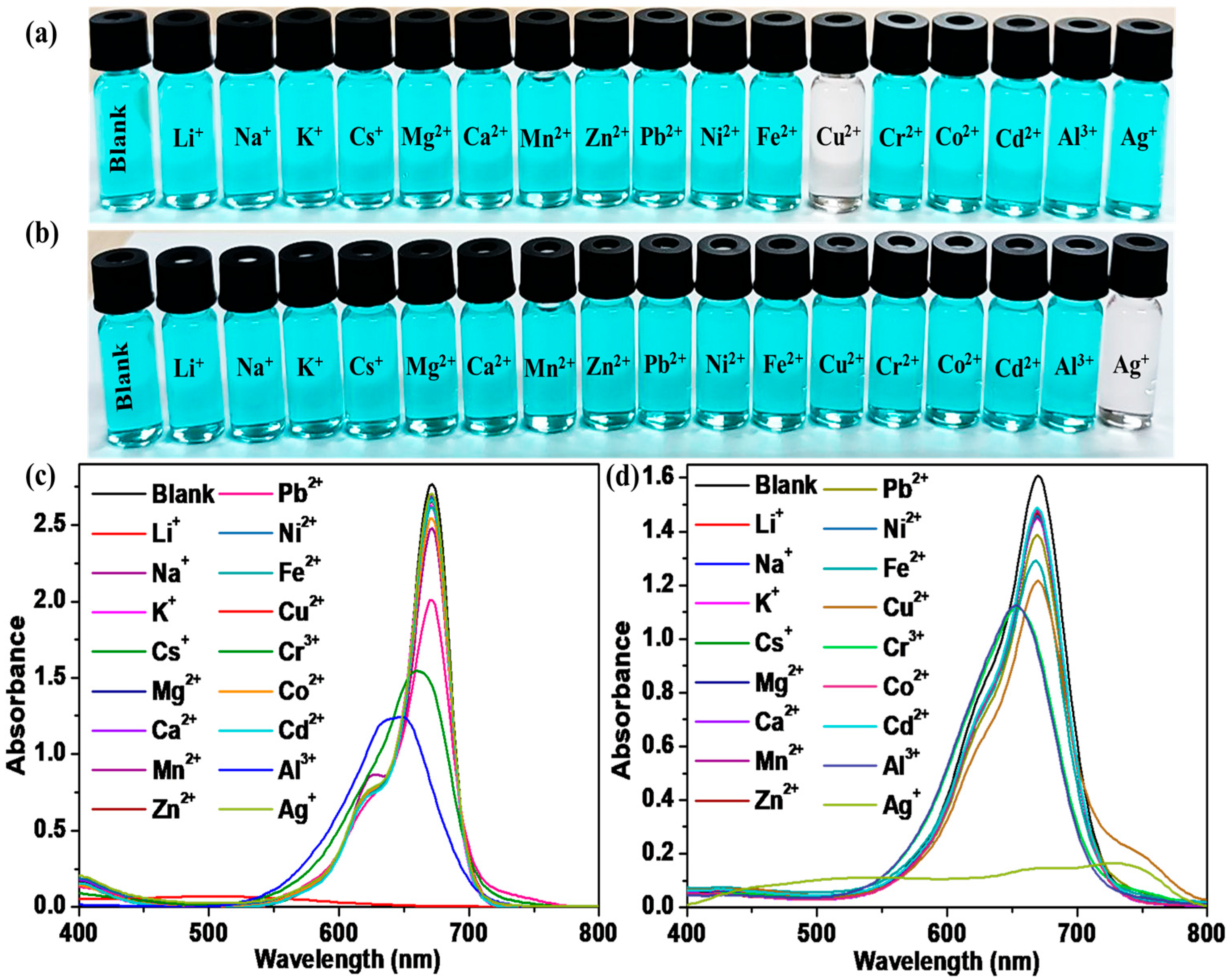
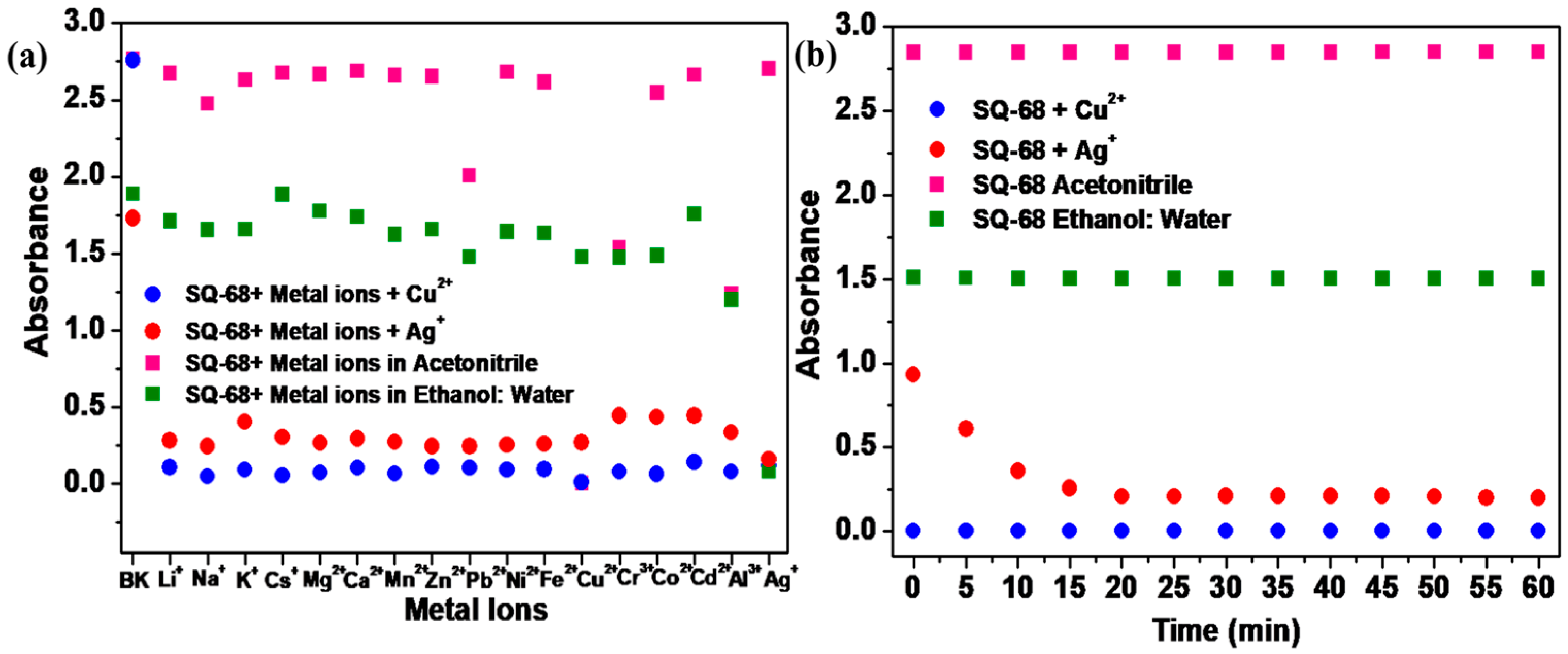
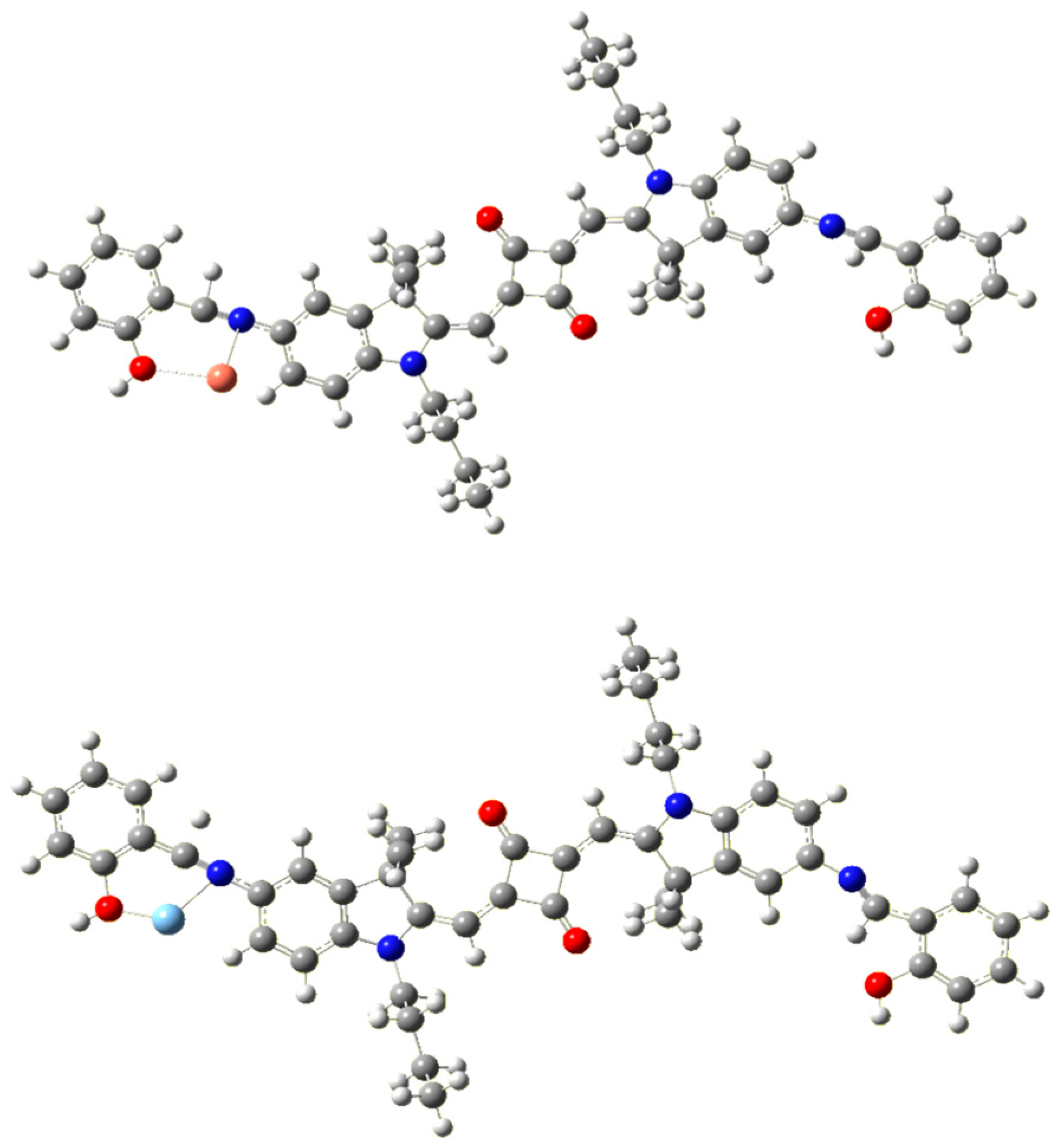


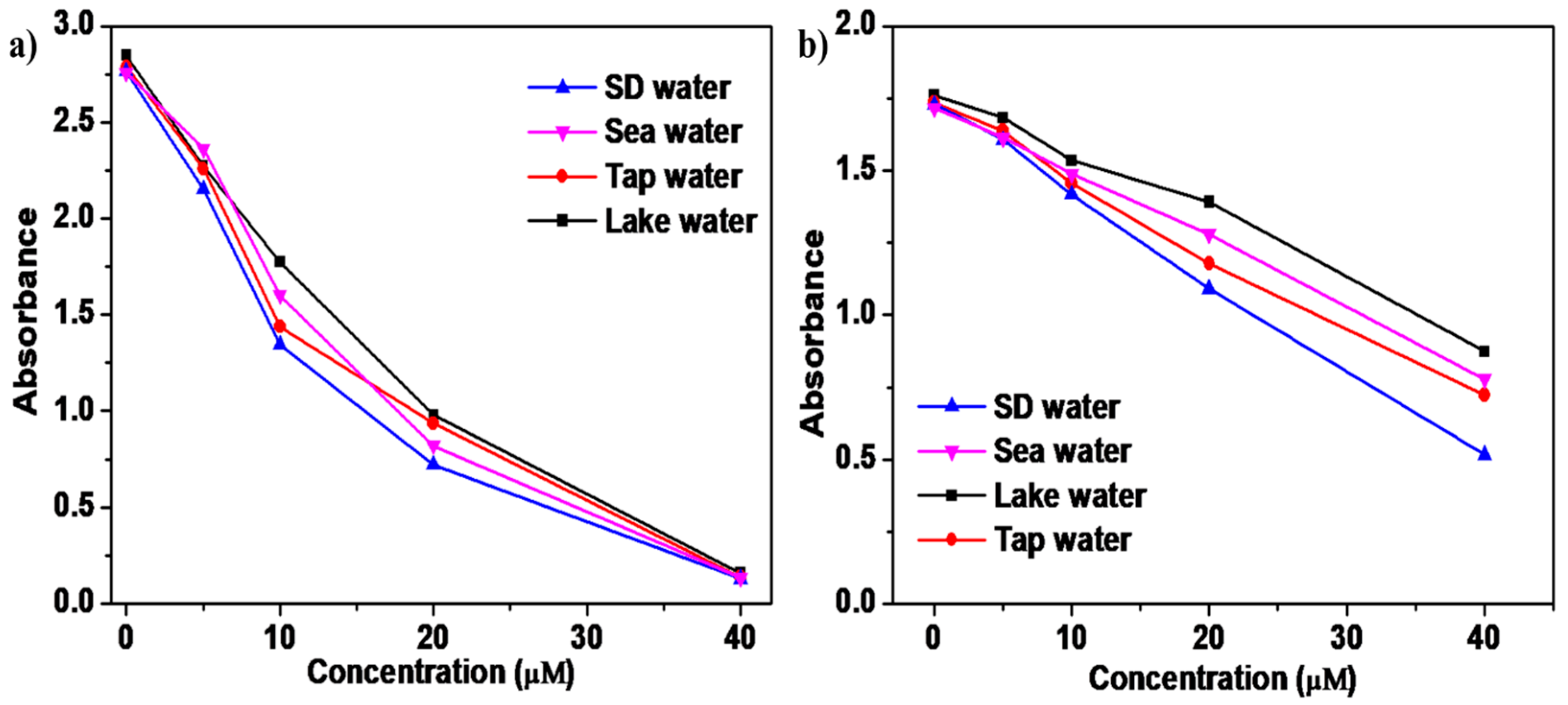
| Solvent | λabs (nm) | λemi (nm) | Stokes Shift (cm−1) | Molar Extinction Coefficient (ε) × 105 L mol−1 cm−1 |
|---|---|---|---|---|
| CH3CN | 672 | 694 | 472 | 2.77 |
| EtOH: H2O (1:1, v/v) | 670 | 710 | 840 | 1.52 |
| Probe | Probe Name | Solvent System | Sensing Method | LOD (μM) | Ref. |
|---|---|---|---|---|---|
 | L | MeOH/Tris buffer (1:1, v/v) | Fluorescent sensor | 0.44 Ag+ | [42] |
 | 5-(-4-fluorobenzylideneamino)-6-amino-2-mercaptopyrimidin-4-ol | DMF/HEPES buffer (1:1, v/v) | Colorimetric and Fluorescent sensor | 1.12 Ag+ | [43] |
 | TPE-4DDC | H2O/THF | Fluorescent sensor | 0.87 Ag+ | [44] |
 | RBTP | H2O/THF | Fluorescent sensor | 0.45 Ag+ | [45] |
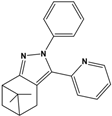 | PPN | DMF/PBS | Colorimetric sensor | 0.86 Ag+ 0.56 Cu2+ | [46] |
 | Probe 1 and Probe 2 | DMSO/PBS buffer | Colorimetric and Fluorescent sensor | 0.22 and 0.72 Cu2+ | [47] |
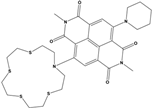 | NDI-4 | CH3CN | Fluorescent sensor | 4.0 Cu2+ | [48] |
 | 1 | HEPES buffer/CH3CN (40:60, v/v) | Fluorescent sensor | 0.95 Cu2+ | [49] |
 | Probe PQ | HEPES buffer | Fluorescent sensor | 0.15 Cu2+ | [50] |
 | SQ-68 | CH3CN Ethanol: Water (1:1, v/v) | Colorimetric Sensor | 0.38 Ag+ 0.09 Cu2+ | Our work |
Disclaimer/Publisher’s Note: The statements, opinions and data contained in all publications are solely those of the individual author(s) and contributor(s) and not of MDPI and/or the editor(s). MDPI and/or the editor(s) disclaim responsibility for any injury to people or property resulting from any ideas, methods, instructions or products referred to in the content. |
© 2025 by the authors. Licensee MDPI, Basel, Switzerland. This article is an open access article distributed under the terms and conditions of the Creative Commons Attribution (CC BY) license (https://creativecommons.org/licenses/by/4.0/).
Share and Cite
Thapa, S.; Singh, K.R.; Pandey, S.S. Efficient and Selective Multiple Ion Chemosensor by Novel Near-Infrared Sensitive Symmetrical Squaraine Dye Probe. Chemosensors 2025, 13, 288. https://doi.org/10.3390/chemosensors13080288
Thapa S, Singh KR, Pandey SS. Efficient and Selective Multiple Ion Chemosensor by Novel Near-Infrared Sensitive Symmetrical Squaraine Dye Probe. Chemosensors. 2025; 13(8):288. https://doi.org/10.3390/chemosensors13080288
Chicago/Turabian StyleThapa, Sushma, Kshitij RB Singh, and Shyam S. Pandey. 2025. "Efficient and Selective Multiple Ion Chemosensor by Novel Near-Infrared Sensitive Symmetrical Squaraine Dye Probe" Chemosensors 13, no. 8: 288. https://doi.org/10.3390/chemosensors13080288
APA StyleThapa, S., Singh, K. R., & Pandey, S. S. (2025). Efficient and Selective Multiple Ion Chemosensor by Novel Near-Infrared Sensitive Symmetrical Squaraine Dye Probe. Chemosensors, 13(8), 288. https://doi.org/10.3390/chemosensors13080288






